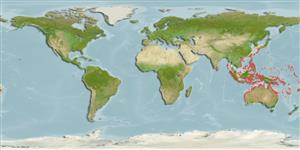>
Gobiiformes (Gobies) >
Gobiidae (Gobies) > Gobiinae
Etymology: Gobiodon: Latin, gobius = gudgeon + Greek, odous = teeth (Ref. 45335).
Environment: milieu / climate zone / depth range / distribution range
Ekologi
laut berasosiasi dengan karang; kisaran kedalaman 0 - 8 m (Ref. 94251). Tropical
West Pacific: Indonesia, Cocos Is., Japan (Ryukyu Is.), Micronesia (Ponape), Australia and Papua New Guinea.
Size / Weight / umur
Maturity: Lm ? range ? - ? cm
Max length : 5.4 cm TL jantan/; (Ref. 11344)
deskripsi pendek
Morfologi | Morfometrik
Duri punggung (Keseluruhan (total)): 7; duri punggung lunak (Keseluruhan (total)): 10-11; Duri dubur 1; Sirip dubur lunak: 8 - 10; vertebrata, bertulang belakang: 26. This species possess many reddish spots/stripes on a yellow-green or sky-blue body; when alive or freshly-collected, it can be distinguished from similar reddish-spotted/lined congeners (G. aoyagii and G. histrio), by having the following set of details in color: 5-6 (usually 5) vertical reddish bars on head and pectoral-fin base; bars on cheek and operculum relatively short, usually not or barely reaching dorsally beyond a level of dorsal margin of eye; 3-8 longitudinal series of rounded or longitudinally elongate scarlet/reddish spots on body, sometimes continuous and forming longitudinal stripes; dorsal, anal and caudal fins are pale yellow with very narrow black distal margins; absence of a black spot at dorsoposterior corner of operculum. In alcohol-preserved specimens, all reddish spots are largely or entirely faded, but this species can still be distinguished from congeners by having a deep, inflected interopercle-isthmus groove; a series of minute non-imbricate cycloid scales on midlateral body; 6-7 upper or lower unsegmented caudal-fin rays; absence of a distinct dusky spot at dorsoposterior corner of operculum. Urogenital papilla in males are more narrowed distally and nearly triangular, while is females it is broader and nearly rectangular (Ref. 94251).
Facultative air-breathing (Ref. 126274); This species is observed to be found among branches of table-like corals, usually Acropora nasuta, also A. valida, A. millepora (the coarse branched form) and sometimes
A. tenuis (Ref. 94251).
Life cycle and mating behavior
Kematangan | Reproduksi, perkembang biakan | Pemijahan | telur-telur | Fecundity | Larva
Bi-directional sex change has been confirmed for this species (Ref. 103751).
Shibukawa, K., Suzuki, T. and M. Aizawa, 2013. Gobiodon aoyagii, a new coral goby (Actinopterygii, Gobiidae, Gobiinae) from the West Pacific, with redescription of a similarly colored Congener Gobiodon erythrospilus Bleeker, 1875. Bull. Nat. Mus. Nat. Sci. 39(3):143-165. (Ref. 94251)
Status IUCN Red List (Ref. 130435)
ancaman kepada manusia
Harmless
penggunaan manusia
informasi lanjut
Umur / SaizPertumbuhanpanjang-beratpanjang-panjangukuran frekuensiMorfometrikMorfologiLarvaDinamika larvapemulihanKelimpahanBRUVS
AcuanBudidaya airprofil budidaya airStrainGenetikaElectrophoresesDiturunkanPenyakit-penyakitPengolahanNutrientsMass conversion
mitraGambarStamps, Coins Misc.Suara-suaraCiguateraKecepatanTipe renangArea insangOtolithsOtakPenglihatan / visi
Alat, peralatan
laporan khas
muat turun XML
Sumber internet
Estimates based on models
Preferred temperature (Ref.
123201): 24.6 - 29.3, mean 28.5 °C (based on 1991 cells).
Phylogenetic diversity index (Ref.
82804): PD
50 = 0.5000 [Uniqueness, from 0.5 = low to 2.0 = high].
Bayesian length-weight: a=0.01995 (0.00906 - 0.04395), b=3.01 (2.83 - 3.19), in cm total length, based on all LWR estimates for this body shape (Ref.
93245).
Trophic level (Ref.
69278): 3.4 ±0.5 se; based on size and trophs of closest relatives
Daya lenting (Ref.
120179): Tinggi, Waktu penggandaan populasi minimum kurang dari 15 bulan (Preliminary K or Fecundity.).
Fishing Vulnerability (Ref.
59153): Low vulnerability (10 of 100).
Nutrients (Ref.
124155): Calcium = 207 [89, 434] mg/100g; Iron = 1.03 [0.49, 2.13] mg/100g; Protein = 18 [16, 20] %; Omega3 = 0.111 [0.043, 0.230] g/100g; Selenium = 19.7 [8.8, 44.3] μg/100g; VitaminA = 92.3 [22.1, 375.0] μg/100g; Zinc = 2.23 [1.36, 3.55] mg/100g (wet weight);
